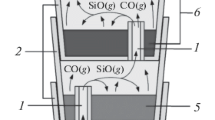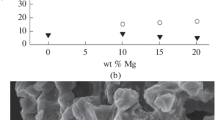Abstract
The kinetic analysis of the formation of the Ti3SiC2 MAX phase by the aluminothermic reduction of TiO2 and SiO2 in the presence of carbon is being studied for the first time. The mixture was subjected to simultaneous thermogravimetry—differential thermal analysis in an argon atmosphere at different heating rates. It was observed that the aluminothermic reduction of the oxide content took place in two steps followed by formation of binary carbides to obtain nano-layered structure of 312 TiSiC phase. It was suggested that the formation of Ti3SiC2 occurred by the in situ reaction of intermediate phases such as TiSi, Ti2Si3, SiC and TiC. The kinetics parameters, including the activation energy for the Ti3SiC2 phase, were measured using the Kissinger method. The activation energy was found to be − 269 ± 7 kJ mol−1. It is also suggested that for preventing any oxidation of Ti3SiC2 phase, a high-grade purity or pre-purified-grade argon should be used.








Similar content being viewed by others
References
Paul A, Jayaseelan DD, Venugopal S, Zapata ES, Binner J, Vaidhyanathan B, Heaton A, Brown P, Lee WE. UHTC composites for hypersonic applications. Am Ceram Soc Bull. 2012;91(1):22–9.
Amelkovich YA, Astankova AP, Tolbanova LO, Llin AP. Synthesis of titanium and zirconium nitrides by burning mixtures of their oxides with aluminium nano powder in air. Ref Ind Ceram. 2007;48(6):425–8.
Zoua B, Ji W, Huanga C, Wanga J, Li S, Xua K. Effects of superfine refractory carbide additives on microstructure and mechanical properties of TiB2–TiC–Al2O3 composite ceramic cutting tool materials. J Alloy Compd. 2014;585:192–202.
Feia YH, Huangb CZ, Liub HL, Zoub B. Mechanical properties of Al2O3–TiC–TiN ceramic tool materials. Ceram Int. 2014;40:10205–9.
Hwu HH, Chen JGG. Surface chemistry of transition metal carbides. Chem Rev. 2005;105:185–212.
Nowontny H. Strukturchemie einiger verbindungen der ubergangsmetalle mit den elementen C, Si, Ge, Sn. Prog Solid State Chem. 1971;5:27–70.
Barsoum MW, El-Raghy T. Synthesis and characterization of a remarkable Ceramic: Ti3SiC2. J Am Ceram Soc. 1996;79:1953–6.
Yoo HI, Barsoum MW, El-Rabhy T. TiSiC; A material with negligible thermo power over an extended temperature. Nature. 2000;407:581–2.
Barsoum MW, El-Raghy T. The max phases: unique new carbides and nitride materials. Am Sci. 2001;89:334–43.
Rodovic M, Barsoum MW. Max phases: bridging the gap between metals and ceramics. Am Ceram Soc. 2013;92(3):20–7.
Sun ZM. Progress in research and development on MAX phases: a family of layered ternary compounds. Int Mater Rev. 2011;56(3):143–6.
Hoffman EN, Vinson DW, Sindelar RL, Tallman DJ, Kohse G, Barsoum MW. MAX phase carbides and nitrides: properties for future nuclear power plant in-core applications and neutron transmutation analysis. Nucl Eng Des. 2012;244:17–24.
Etzkorn J, Ade M, Hillebrecht H. Ta3AlC2 and Ta4AlC3-single-crystal investigations of two new ternary carbides of tantalum synthesized by the molten metal technique. Inorg Chem. 2007;46:1410–8.
Atasoy A. The aluminothermic reduction of boric acid. Int J Refract Met Hard Mat. 2010;28:616–22.
Mishra SK, Khusboo A, Sherbokov V. Fabrication of in situ Ti-Si-C fine grained composite by the self-propagating high temperature synthesis(SHS). Int J Refract Met Hard Mat. 2011;29:209–13.
Hu CF, Sakka Y, Tanaka H, Nishimura T, Grasso S. Low temperature thermal expansion, high temperature electrical conductivity and mechanical properties of Nb4AlC3 ceramic synthesized by spark plasma sintering. J Alloys Compd. 2009;487:675–81.
Gupta S, Barsoum MW. Synthesis and oxidation of V2AlC and (Ti0.5V0.5)2AlC in air. J Electro Chem Soc. 2004;151:24–9.
Zamulaeva EI, Levashov EA, Sviridova TA, Shvyndina NV, Petrzhik MI. Pulsed electro spark deposition of MAX phase Cr2AlC based coating on titanium alloy. Surf Coat Technol. 2013;235:454–60.
Yanzhi CY, Yin H, Pan L, Chen P, Sun G. Microstructures and mechanical properties of Ti3SiC2/TiC-Al2O3 composites synthesized by reactive hot pressing. Mat Sci Eng A. 2013;571:137–43.
Abdulkadim A, Baben M, Takahashi T, Schnabel V, Hans M, Polzer C, Polcik P, Schneider JM. Crystallisation kinetics of amorphous Cr2AlC thin films. Surf Coat Technol. 2011;206:599–603.
Riley DP, Kisi EH, Hansen TC. Self-Propagating high temperature synthesis of Ti3SiC2: II. Kinetics of ultra-high-speed reactions from in situ neutron diffraction. J Am Ceram Soc. 2008;91:3207–10.
Wu E, Riley DP, Kisi EH, Smith RI. Reaction kinetics in Ti3SiC2 synthesis studied by time-resolved neutron diffraction. J Eur Ceram Soc. 2005;25:3503–8.
Kissinger HE. Reaction kinetics in differential thermal analysis. Anal Chem. 1957;29:1702–6.
Aydınyan SV, Nazaretyan KT, Zargaryan AG, Tumanyan ME, Kharatyan SL. Reduction mechanism of WO3 + CuO mixture combined Mg/C reducer. J Therm Anal Calorim. 2018. https://doi.org/10.1007/s1097301869855.
El-sadık MH, Ahmed HM, El-barawy K, Morsi MB, El-didamony H, Björkmam B. Non-isothermal carbothermic reduction kinetics of mechanically activated ilmenite containing self-reducing mixtures. J Therm Anal Calorim. 2018;131:2457–65.
Jelic D, Zeljkoviç S, Şkundriç B, Mentus S. Thermogravimetric study of the reduction of CuO-WO3 oxide mixtures in the entire range of molar ratios. J Therm Anal Calorim. 2018;132:77–90.
Kumar DS, Ananthasivan K, Krishnan RV, Senapati A. Reaction mechanism and kinetics analysis of citrate gel-combustion synthesis of nanocrystalline urania. J Therm Anal Calorim. 2018;131:2467–76.
Wang Y, Wang XY, Hua XN, Zhao CC, Wang W. The reduction mechanism and kinetics of Fe2O3 by hydrogen for chemical looping hydrogen generation. J Therm Anal Calorim. 2017;129(3):1831–8.
Author information
Authors and Affiliations
Corresponding author
Rights and permissions
About this article
Cite this article
Atasoy, A. Reaction mechanism and kinetics in Ti3SiC2 synthesised from oxides. J Therm Anal Calorim 134, 363–370 (2018). https://doi.org/10.1007/s10973-018-7572-5
Received:
Accepted:
Published:
Issue Date:
DOI: https://doi.org/10.1007/s10973-018-7572-5




